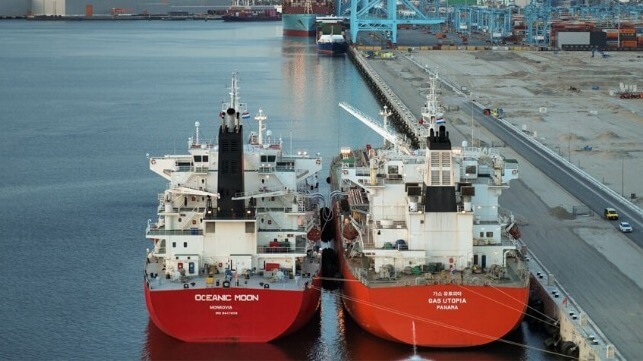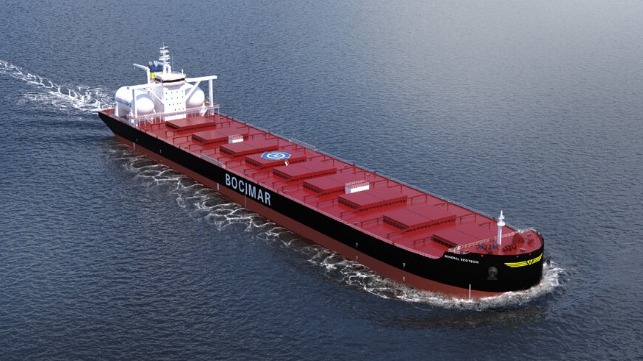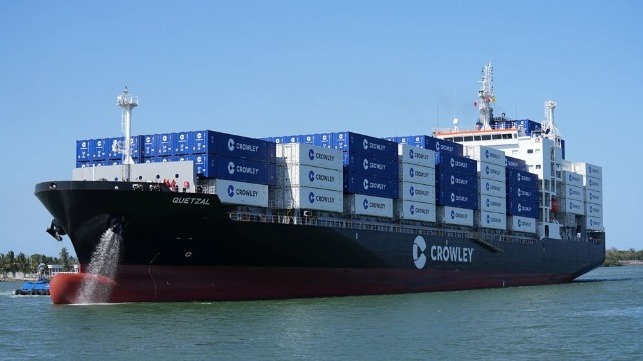ALT. FUELS
Port of Rotterdam Hosts Pilot to Test Steps for Ammonia Bunkering

The first test steps were undertaken at the Port of Rotterdam to test the port’s capabilities for future ammonia bunkering operations. Rotterdam is the world’s second-largest bunker port and expects that ammonia-fueled vessels requiring bunkering will begin in 2026 or 2027. It looks to build on its existing efforts for LNG bunkering and now methanol to prepare for the future alternative fuel.
The port highlights that the safety protocol levels were raised to prepare for the test. The port has already implemented assessment tools so that it is fully ready for LNG and now methanol. Port officials said the raised levels and testing of the process will ensure it is prepared for bunkering of the first ammonia-fueled vessels.
The pilot on April 12 involved transferring 800 cubic meters of liquid, cold ammonia at -33 degrees Celsius between two ships. It took about 2.5 hours and was conducted alongside a new quay at the Maasvlakte 2 APM terminal. For this test grey ammonia was used but the port anticipates that clean (low carbon) ammonia will be used when the bunkering operations begin. They noted that the gray ammonia shares the same chemical properties as the future clean product helping to test the protocols.
Various parties collaborated on the pilot, facilitated by the Port of Rotterdam Authority. OCI, owner and operator of the port’s ammonia terminal, partnered with Trammo, which supplied the two tankers carrying OCI’s ammonia. James Fisher Fendercare provided equipment and expertise to ensure the safe execution of the ship-to-ship transfer at the berth location provided by APM Terminal. Bunker barge operator Victrol shared its bunkering expertise during the preparation of the pilot. The DCMR Environmental Protection Agency, Rijnmond Safety Region (VRR), and the Joint Fire Service (GB) were involved to ensure the pilot was conducted safely and smoothly.
Rotterdam’s test followed a similar testing process that was carried out last year in Singapore. Fortescue’s converted offshore support vessel received the first bunkering as the Maritime and Port Authority tested its protocols and certified the vessel. In Japan, they are using tanker trucks to fuel the world’s first tugboat using ammonia. Demonstrations of the tug have been undergoing in Tokyo Bay with it supporting ship traffic after having operated for a decade as an LNG-fueled tug.
DNV calculates that there are currently 33 vessels on order due for delivery in the next four years that will be capable of sailing using ammonia as a fuel. CMB.TECH and Fortescue announced a deal today, April 14, for the Australian mining company to use one of the Belgian company’s first ammonia-fueled Newcastlemax bulkers due for delivery in 2026. Mitsui O.S.K. Lines has also announced that it will co-own and operate three of the 210,000 dwt ammonia-fueled bulkers.
Developing the infrastructure for bunkering is a critical step. Last year, Fortescue complained that it could not demonstrate its vessel on ammonia due to a lack of infrastructure and enable regulations. The companies look at their current efforts as pioneering and contributing to the development of the infrastructure needed to encourage the industry to accelerate the conversion to ammonia as one of the alternative fuels.
Fortescue to Operate Ammonia-Fueled Ore Carrier from CMB.TECH

Australian mining giant Fortescue and the Saverys family’s CMB.TECH signed a charter agreement which the companies are calling a landmark in the efforts to accelerate the deployment of ammonia-fueled vessels and the decarbonization of large, long-distance vessels. Fortescue will deploy one of the fleet of 210,000 dwt ammonia-fueled bulkers currently being built by CMB.TECH.
Bocimar, the bulker operator under the CMB.TECH umbrella reported in 2023 that it was working with WinGD to co-develop large ammonia-fuelled engines. The companies said they were aiming to install the ammonia dual-fuel X72DF engine on a series of 10 bulk carriers to be built at a Chinese shipyard in 2025 and 2026. By the end of 2023, they had progressed in announcing an agreement with CSSC Qingdao Beihai Shipbuilding (QBS) to build the vessels and engine builder CSSC Engine Co (CSE) to construct China’s first ammonia dual-fuel engines.
The project was based on WinGD’s X92B engine, which they said would be an ideal starting point for developing large-bore ammonia-fueled engines. The design was for a 72-bore ammonia engine operating using high-pressure fuel injection with a small portion of pilot fuel.
“Our landmark agreement with Bocimar sends a clear signal to the market – now is the time for shipowners to invest in green ammonia-powered ships. The days of ships operating on dirty bunker fuel, which is responsible for three percent of global carbon emissions, are numbered,” said Dino Otranto, CEO of Fortescue Metals. “We will continue to work with like-minded companies like Bocimar to transition our fleet to low and zero-emissions vessels and help accelerate the widespread adoption of green ammonia as a marine fuel.”
The vessel is expected to be delivered by the end of 2026. Will be a dual-fuel Newcastle bulker. It will be employed to transport iron ore from the Pilbara region of Australia to customers in China and around the world.
Alander Saverys who is a strong advocate for decarbonization and at the forefront for ammonia and hydrogen-fueled vessels called the deal the “beginning of an exciting journey to build more ammonia-powered ships.” He believes that it will “stimulate more green ammonia production projects.”
Fortescue launched the first ammonia dual-fuel vessel last year with a converted offshore support vessel which also conducted the first ammonia bunkering operation in Singapore. The vessel went through extensive testing as part of a certification progress in Singapore. The vessel sailed to London in early March to call attention to ammonia ahead of the recent IMO meetings and according to the company will soon embark on a tour of global ports.
The agreement with Fortescue follows a deal between CMB.TECH and Mitsui O.S.K. Lines announced in March that the Japanese shipping company would jointly own three of the 210,000 dwt bulk carriers. It will take the three vessels on a long-term charter for operations and also plans to build six chemical tankers. Two of the vessels will be ammonia-fitted on delivery and the other four will be built ammonia-ready with delivery between 2028 and 2029.
Crowley Adds First New LNG-Powered Ship for Caribbean and Central America

U.S. logistics company Crowley has begun operations with the first of its new LNG-powered boxships for operation in the Caribbean and Central American market.
The newly-delivered Quetzal is a 1,400 TEU feeder powered by dual-fuel LNG propulsion. The design is fitted to accommodate high volumes of reefer cargo for the region's busy cold chain trade, capable of handling 300 reefer unit plugs. Flexibility for a variety of cargo types and sizes was at top of mind during the design process, including breakbulk cargoes.
Crowley’s "Avance-class" ships are built with high pressure ME-GI engines from MAN, which greatly reduce methane slippage and make the four ships the most environmentally efficient in their category, according to Crowley.
Quetzal's first commercial port call was at Santo Tomas, Guatemala on April 11-12. Like her sisters, she is owned by Singapore's Eastern Pacific Shipping and built at Hyundai Mipo, and she is flagged with the international registry of Liberia.
"Quetzal and the Avance Class ships represent the next generation of Crowley’s innovation and leadership in supply chain solutions for international shipping in the Caribbean Basin," said Tom Crowley, Chairman and CEO. "The vessels provide frequent service and greater capabilities to deliver cargo at peak timing while carrying forward Crowley’s high operational standards. With the company’s decades of service in Central America and the Dominican Republic, the Avance Class is a strategic investment by Crowley in the future of this international trade."
No comments:
Post a Comment